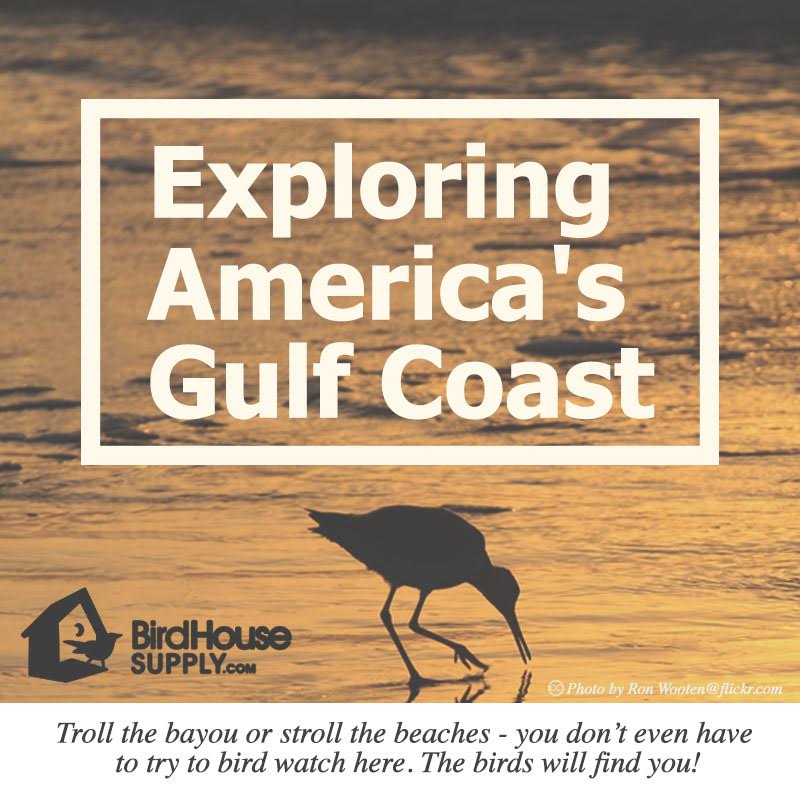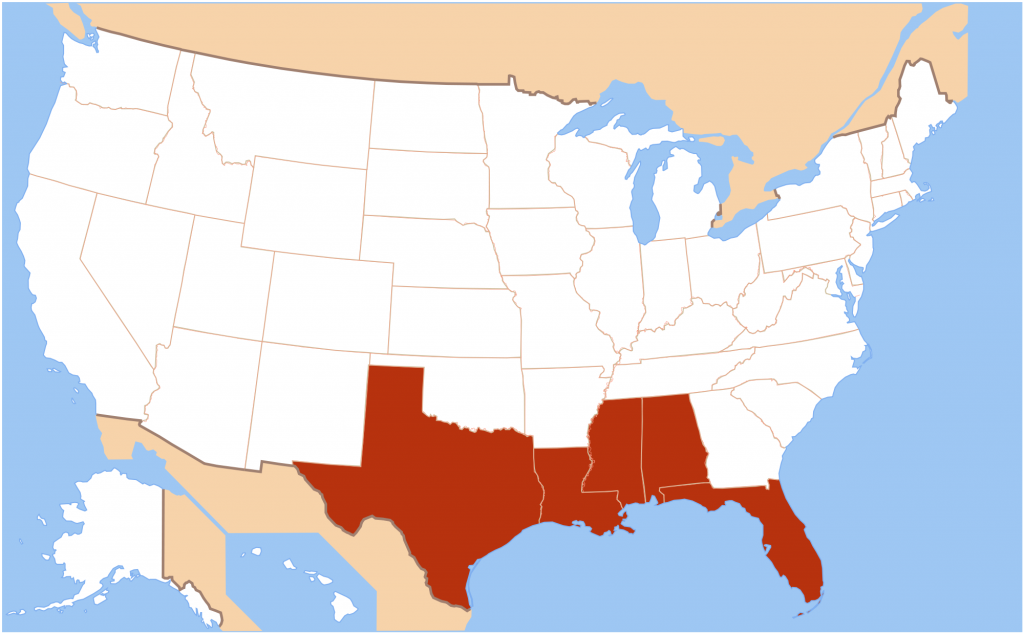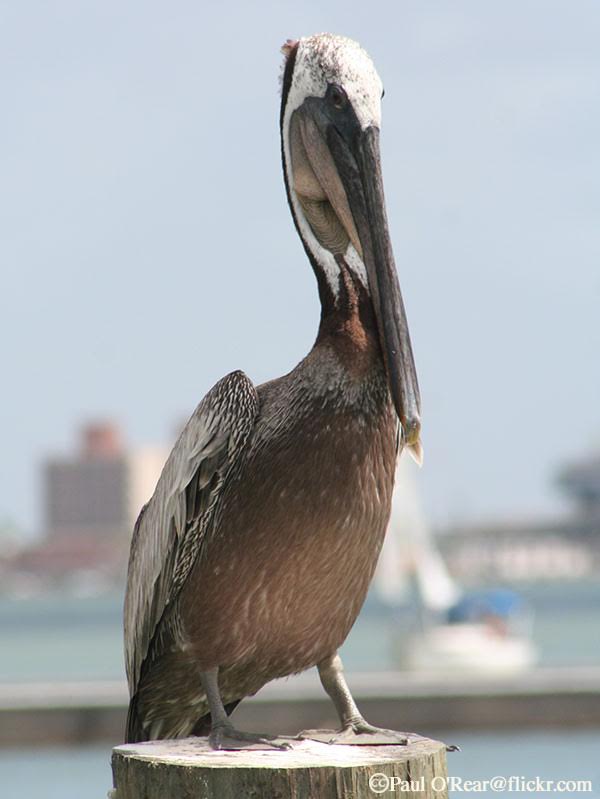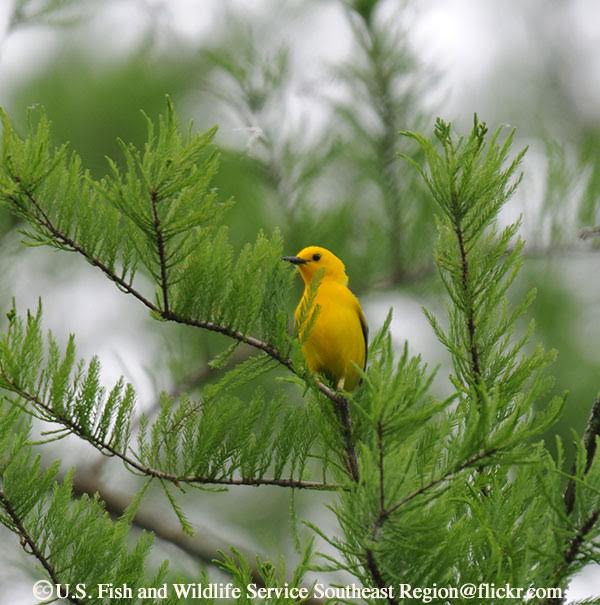Doing just one thing while in the Gulf is impossible.
You will walk in the paths of history while banding birds at Fort Morgan, admire the grandeur of antebellum mansions as you smile at the elegant egrets, and enjoy day boat seafood with the languid Brown Pelicans. Troll the bayou or stroll the beaches – you don’t even have to try to bird watch here. The birds will find you!
The American Gulf coast stretches from the western edge of sunny Florida to the stunning shores of eastern Texas.
Who can pass up Louisiana and the Big Easy, the Mississippi Delta (the “King of Waters”) and amazing Alabama? The Gulf coast is rich in history – from the earliest Native American settlements to the coming of the Creole and Cajun. This region is a historian’s dream. Of course, there is no need to mention the culinary delights drawing from the teeming coast and the luxurious long-growing season of this area’s gardens and farms. It would be hard to find someone who hasn’t heard of The Blues or Jazz?
Why the Gulf Coast is great for birds
Those feathered flocks aren’t silly; they know a great locale when they see it. Migratory species wing their way to this expanse of ecological significance. This is where the Central Flyway and the Mississippi Flyway merge in a spectacular assembly of avian life known as the “river of birds.” The feathered gathering echoes the soul of this region as you steep in the cultural headwaters of Native American, Spanish, British, French and African influences. The Gulf Coast is a place to get lost in, and once you start taking in the bird life, you may never want to leave…
Residents of the Gulf should maintain a variety of feeding stations to take into consideration the diversity of birds winging through. These stations will serve the sedentary and migratory species. Set out traditional mixed seed and sunflower tubes and trays, nectar or hummingbird feeders and suet cages. Try adding field corn, fruit and nuts and a selection of landscaping plants that feed and house birds. Your local garden center will have a wide selection of plantings suited to maritime environments and the warmer “zones” of the coast. Before planning your trip, visit the American Birding Association’s page to peruse the birding trails in North America.
Explore the different regions of the Gulf Coast
The American Gulf Coast is too big to enjoy in just one trip, unless you have at least a few weeks. Choose one of these regions and get packing…
- Florida’s Perdido Key – Sweeping stretches of saltgrass beaches welcome bird watchers to Perdido Key. Set at the mouth of Pensacola Bay, this preserve boasts briny shores, rolling dunes, marine pinelands and a marsh. There is a fee, so plan ahead. Part of the birding trail includes a boardwalk (where Swainson’s Warblers are recorded in the spring!) – great for children or for those with disabilities. The Key’s varied ecosystem provides nesting sites for shore and songbirds including pelagic species. Night viewing is available by special request. Expect to see a wide selection of fall and winter visitors from Spotted Sandpipers and Northern Gannets to Snowy Plovers and Least Terns. The pine stands host tropical songbirds as well as towhees, warblers and other favorites.
Alabama’s Many Wonders
There’s plenty for a bird watcher to see along the Alabama trails. Such as…
- The Alabama Birding Trail – The Alabama Birding Trail resource is your go-to site for investigating the abundant (430 species) birdlife that visit or call Alabama home. The site lists parks to visit, events and general information for nature fans, school excursion groups and seasoned bird watchers. From the northern border to the salty coast, you can walk the top bird watching spots uncovered by this group’s ten years of research. Funded and shaped through the assistance of Alabama’s park services, in partnership with the regional Audubon Society – the “Alabama Birding Trail” is a sure bet for birding excitement.
- The Hugh S. Branyon Back Country Trail – The Hugh S. Branyon Back Country Trail is another “must-visit” nature park. The 15 miles of walking trails at the Hugh S. Branyon are truly diverse – plan to hover in the tranquility of “the timeless beauty of the Butterfly Garden, the mystical Freshwater Marshes and the Coastal Hardwood Swamps.” Camping is available and you can sign up for guided tours. Keep an eye out for deer, black bear, otters, boar and the engaging American Alligators. This varied ecosystem (6 regions including marshland, tree-studded swamps, maritime pine woods, dunes and sand grasses) supports a sweeping variety of bird life, endangered plant species and wildlife. From gallinaceous species and woodcock, to Snowy Egrets and Brown Pelicans, this trail will have you migrating with the feathered flocks.
- Dauphin Island – Dauphin Island, Alabama is renowned for its stretches of shoreline and exceptional beauty. The 14 mile-long island is one of the premier migratory bird watching reserves. Walk pristine forests, marsh-grass covered dunes, wetlands, a rich swampland and even a lake – this region is a naturalist’s Mecca. 137 acres encompasses the Audubon Society’s “Sanctuary.” The island is the first port-of-call for birds crossing the Gulf from South America in their spring migrations north. Within this critical ecosystem, the Audubon Society has documented visits by 95% of the bird species in the state of Alabama. Labeled a “Globally Significant” habitat, campers and beach-lovers will mingle with ornithologists, and historians will find time to trek to Fort Gaines where costumed interpreters lead tours through the fort.
Dauphin Island Species list:
| Wilson’s Plover | Red Phalarope | Caspian Tern | Jaegers |
| Brown Pelican | Bonaparte’s Gull | Magnificent Frigatebirds | Common Moorhen |
| Rails and Gallinules | Sandhill Crane | Pileated Woodpecker | Burrowing Owl |
| Peregrine Falcon | Golden Eagle | warblers | weavers |
| hummingbirds | tanagers | finches | cuckoos |
| sparrows | and more! |
- Fort Morgan – For those interested in a more structured ornithological jaunt, don’t miss out on the bird-banding at historic Fort Morgan. Sign-up to be a volunteer bander at the Fort! The operation, led by trained birders, begins in mid-April. Accommodations are available for rent, so you can set up your nest close to the action. Records are collected and maintained to study the migration pattern, condition, and population of the neotropical species winging their way up from South America. Weather impact analysis is also recorded. Fort Morgan is a pivotal land stretch for the birds on their seasonal journeys. The census is “run by the Hummer/Bird Study Group, Inc., is set up in Fort Morgan because it’s the first landfall and last place of departure for thousands of migrating birds, including ruby-throated hummingbirds.” Don’t forget to keep an eye out for other winged travelers, since Monarch butterflies use the Fort as their stopover before fluttering on to the tropics.
Mississippi’s Many Wonders
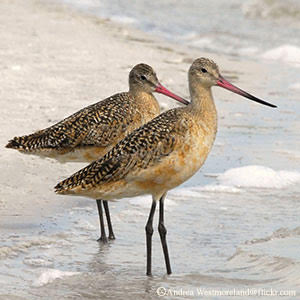 From barrier islands to bird preserves, Mississippi is a quiet wonder when it comes to birding stops along the Gulf of Mexico.
From barrier islands to bird preserves, Mississippi is a quiet wonder when it comes to birding stops along the Gulf of Mexico.
- Mississippi Barrier Islands – (Cat Island, Horn Island, Deer Island, Petit Bois Island, Ship Island) Barrier islands protect inland regions from the eroding action of surf as they buffer the impact from storm surges and hurricane swells. Miles of maritime forests, marshes and dunes stand as refueling and breeding areas for avian visitors as well as wildlife. These five islands lining the coast of Mississippi host heritage sites, Native American settlements and bird watching opportunities that are worth the trek.
- Cat Island – Cat Island sports a comic misnomer. Spanish adventurers witnessed raccoons for the first time and mistook these furry explorers for cats (the Spaniards were lucky the island wasn’t populated by skunks – “here, kitty, kitty”). The island hosts a wide variety of songbird, shore and pelagic species. Natural resources include stretches of sand dunes, pine and live oak maritime forests and inland marshlands.
- Horn Island – Horn island is a compact ecosystem (barely a mile wide) sporting sandy beaches, marsh grasslands and oat patches, pine stands and several lagoons. Bird watching in this prime locale will yield results!
- Deer Island – Deer Island folk stories claim the name is derived from deer swimming from the mainland. This island is not far from the Mississippi mainland and it is an easy trek for deer and bird watchers. Once inhabited by Native Americans, the modern dwellers were displaced by hurricane Camille. Shorebirds and open ocean flyers disembark at this port.
- Petit Bois Island – Petit Bois Island – these “little woods” embrace some great birdlife! Subtidal estuarine habitat brings in the hungry seabirds.Keep an eye out for Snowy and Wilson’s Plovers, Brown Pelicans, Least Bitterns, Laughing Gulls (largest breeding colony), Osprey, Common Moorhens and Clapper Rails.
- Ship Island – Ship Island is for sailors. Clamber aboard the ferry to visit the island. Keep one eye on the Royal Terns, and the other on the nesting sea turtles! Ship Island has hosted Magnificent Frigatebirds, American Kestrels, American Oystercatchers, and Dunlins.
- Grand Bay National Estuarine Research Reserve – 18,000 areas of bay, shellfish and seagrass beds, salt marsh, salt pannes, maritime pine, cypress forests and bayou supports plant species, wildlife and researchers. The reserve has a full research station monitoring the environment and estuarine area. Join NOAA, universities and government agencies recording wildlife impact and ecological processes and witness field research in action! There are volunteer opportunities. Don’t forget to notice the Bald Eagles cruising the bay.
- Pascagoula Audubon Center – Situated on the Pascagoula River, the Audubon Center offers school trips and nature courses. Take an easy water tour along the river and swamplands. With 150 species of mammal, reptile and amphibian and 200 avian species – you will be quite busy. Sightings have included: American Flamingo, Kinglets, Wood-warblers and hummingbirds.
**Note on the Mississippi Flyway: This critical habitat was significantly affected by the Deepwater Horizon Oil Spill (2010). Visit the Mississippi Audubon Society’s website to learn more about the restorative mission launched by Audubon and the National Fish and Wildlife foundation. Read about the Restore Act and how it is enabling the revival of this ecosystem for the wildlife, flora and people affected by the 2010 oil spill.
Texas
As large as Texas is, there’s a birding adventure waiting for every type of traveler somewhere. Here are just a few of our favorites:
- The Great Texas Coastal Birding Trail – Great Texas Coastal Birding Trail wraps its arms around Houston, Galveston and the northern stretches of the Gulf Coast. This internationally renowned trail is not to be taken lightly!If you are a serious birder this is on your map. Nearly a dozen reserves sit along this extensive collection of ecological delights. The Central and Mississippi Flyways converge onto this trail system. The habitat is as varied as the wildlife – you will need a map, a guide and a lifetime to fully enjoy this excursion! The Texas Trail is the first “official” birding map compiled in the US. In 1996, this “father of the birding trail movement, the Texas coastal trail was the first-and at approximately 2,110 miles-still the longest birding trail. It links 310 sites and 41 counties along Texas’s Gulf Coast, providing a colorful road map to well over half of the 600 species found in the state (3 maps available).” Don’t forget your wildlife and flora guide books. You don’t want to miss anything!
- South Lake River State Park – South Llano River State Park encompasses 2,630 acres west of the Edward’s Plateau. The river’s bed offers hardwood forests of pecan, sycamore, Spanish and Live Oak and elm. These forests are a wildlife hotbed, and they are home to the Rio Grande Wild Turkey. These magnificent birds are worth the trip! Canyonlands are abundant with berries and nut trees – and this means bird life. The varied geography hosts a unique selection of avian species – trek to the arid plateaus or hike the river bottom. Watch for kingfishers, eagles, owls, phoebe, warblers, towhees and game birds.
- Aransas National Wildlife Refuge – Aransas National Wildlife Refuge is home to the endangered Whooping Crane. Since 1941, it has been the premier habitat for the birds’ recovery mission. Try to plan your trip during the peak fall migration to view the birds – the Aransas Refuge (founded 1937) “begins posting updates once the birds begin arriving (around mid-October) and posts information frequently until the birds leave for their summer home in Canada (near the end of March).” Learn more about how the crane populations are assessed using decoys by visiting the “Counting The Birds” page. The refuge is situated amidst barrier islands -the most notable is Matagorda – that welcome alligators, Kemp’s Ridley Sea Turtles and dozens of shore birds. 400 species of birds, migratory and nonmigratory, have been documented in Aransas. The coast is ringed by abundant and sweeping, grassed marshland – reminiscent of coasts along the United Kingdom or Alaska. Follow the waterway as it transforms from brackish to fresh, flowing into the hardwood savannah and prairie-lands.
- Bolivar Loop – Bolivar Loop Dust off the waders and slosh down to the Bolivar Flats. With shorebirds and more shorebirds, these coastal wetland “bogs” and marshlands are a seafood lover’s snack bar with mollusks, shrimp and crunchy invertebrates. The terns and plovers don’t have to flap far, since the salt marsh borders the crustacean dining area. The flats are listed as a “Globally Important Bird Area.” Hiking through the marsh grass is not allowed, as these are the protected nesting areas for the shorebirds, but enjoy the strands and sandy stretches….the birds are waiting. Pack your bags for the migration season and drop us a “postcard” in the comment section. List your favorite Gulf birding haunts and tell us what birds you spotted there!

